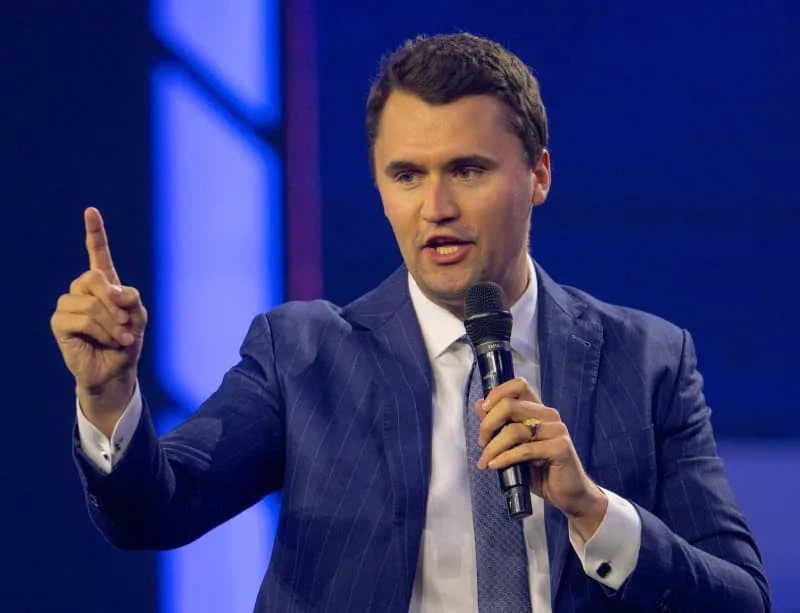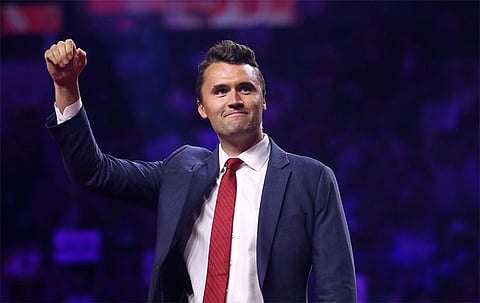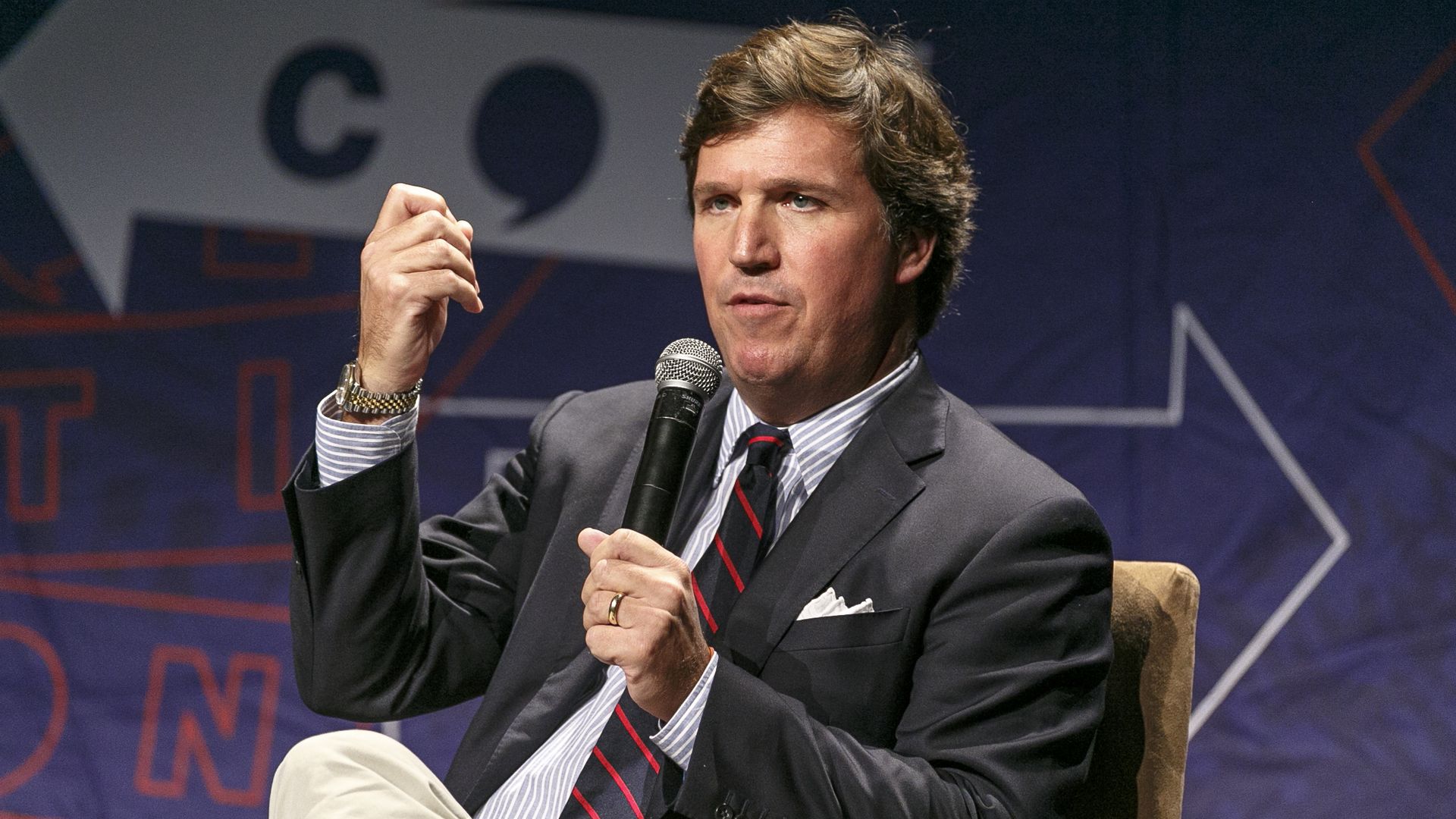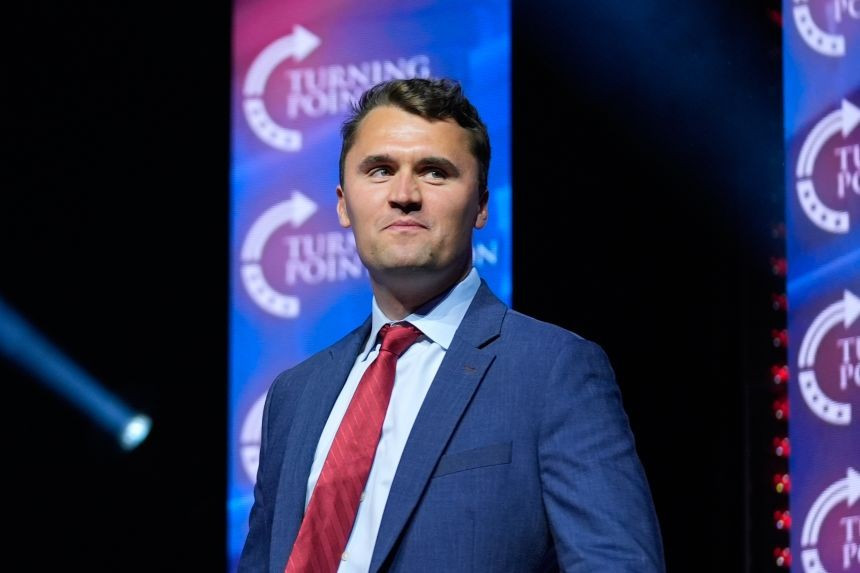Tucker Carlson’s Naked Truth: “They Wanted Us to Be Silent” Charlie Kirk’s @ss@ssin@ti0n Requires Truth Over Belief — What He Just Revealed Live Shocked America! Viet
Tucker Carlson’s Naked Truth: “They Wanted Us to Be Silent” Charlie Kirk’s Assassination Requires Truth Over Belief — What He Just Revealed Live Shocked America!
At 9:57 p.m. Eastern time, October 12, 2025, the studio lights of
“There’s something deeper here,” he began, voice steady but edged with fatigue. “They wanted us to stop asking questions. They wanted us to be silent.”
Viewers across the country felt it immediately: this was not the usual broadcast. Tucker was not debating policy or critiquing headlines. He was testifying—openly, emotionally—about the lingering inconsistencies surrounding Kirk’s death and the growing sense that the truth had been carefully managed, if not buried altogether.

The Background: From Political Icon to Public Mystery
Charlie Kirk had been many things: the founder of Turning Point USA, a strategist, a provocateur, and, to his followers, a symbol of a generation determined to redefine conservative activism. His sudden death, initially described as a tragic “security incident” outside a private event in Phoenix, left both supporters and critics reeling.
Official reports were brief. Local authorities cited “an isolated act of violence.” The perpetrator was allegedly apprehended. Case closed—at least on paper.
But within weeks, journalists noticed contradictions. Timelines didn’t align. Surveillance footage appeared incomplete. A section of digital evidence listed in the case file was later marked
The Leak: Anonymous Voices From Inside
In early October, an encrypted document—labeled Project Orion—arrived in the inbox of several independent reporters. It contained fragments of internal correspondence between law-enforcement analysts, communications staff, and unnamed federal liaisons. The authenticity of the file has never been officially confirmed, but its tone and structure mirrored real administrative documents.
One passage stood out:
“Coordination with media assets recommended. Limit speculative coverage. Priority 1: maintain confidence in official narrative until directive update.”
For Tucker Carlson, who had already spent months dissecting inconsistencies, this was enough to go public. Sources close to the host say he had verified at least two components of the file before deciding to broadcast his findings live.

The Broadcast: Four Minutes That Changed the Conversation
On air, Tucker refrained from accusing anyone directly. Instead, he framed his remarks as a moral and journalistic duty:
“When a citizen dies under circumstances that don’t add up, when evidence disappears and officials refuse to answer basic questions, that’s not politics—that’s accountability. And accountability is what makes us a country.”
He described receiving clips of deleted security footage—showing an “unexplained time gap” of several seconds—and audio logs from what appeared to be Kirk’s final phone call, placed less than two minutes before the fatal moment. Tucker didn’t play the audio, citing “respect for privacy,” but his description alone was enough to stir national debate.
Within hours, hashtags like #KirkFiles, #TuckerReveals, and #SilenceNoMore were trending across social platforms.
Behind the Curtain: Conversations With Insiders
Off-record interviews conducted over several weeks reveal a tense divide inside Turning Point USA. Some senior members, speaking anonymously, expressed frustration that “the organization’s own communications were restricted during the early investigation.” One said bluntly:
“We were told to wait for the official findings, but months later, there’s still nothing. Tucker’s right—people are tired of silence.”
Others warned that conspiracy theories risked overshadowing Kirk’s legacy, describing him as “a visionary caught in a storm bigger than himself.”
Meanwhile, a mid-level staffer provided what they claimed was a snippet from internal financial reports showing irregular transfers during the final quarter of 2024—labeled “event coordination fees.” Investigators reviewing those documents reportedly found no criminal conduct, but the timing, coinciding with the months leading up to Kirk’s death, has fueled speculation about possible motives unrelated to politics.
The Public Response
The morning after Tucker’s broadcast, reaction split along predictable lines. Major networks called his remarks “speculative,” while independent commentators praised his courage. Within 24 hours, congressional aides confirmed that several lawmakers had quietly requested an updated briefing on the Kirk investigation from the Department of Justice.

Erika Kirk, Charlie’s widow, released a short statement through her publicist:
“Our family appreciates anyone seeking the truth. We ask for respect as we continue to mourn.”
It was the first time she had addressed the public since midsummer.
Patterns of Silence: How Investigations Go Missing
To understand why Carlson’s revelations struck such a chord, one must look at the broader pattern of information management in high-profile cases. In the past decade, at least five major political incidents have been marked by abrupt shifts in official narratives. Files vanish, statements are “corrected,” and time stamps mutate between releases.
Dr. Elaine Morgan, a professor of media ethics at Georgetown University, told reporters:
“People aren’t just reacting to this one case. They’re reacting to a decade of feeling excluded from the process of truth-finding. Tucker Carlson tapped into that emotion.”
The Emotional Core: Grief, Doubt, and the Demand for Clarity
Beyond the politics, the tragedy of Charlie Kirk is deeply human. Friends recall a man consumed by his work yet protective of his family. One longtime associate remembered a conversation just weeks before the event:
“He said he felt watched—not in a paranoid way, but uneasy. He joked about needing more sleep, less travel. No one thought it meant anything.”
When that memory resurfaced after Tucker’s broadcast, it resonated painfully with the public narrative of exhaustion, pressure, and unseen forces shaping political life in America.
The Turning Point Debate
Ironically, the organization Kirk founded—Turning Point USA—now faces its own turning point. Internally, a generational clash is brewing: younger staffers demanding full transparency versus veterans urging restraint to preserve the brand.

One insider summed it up:
“Charlie always said sunlight is the best disinfectant. If he were here, he’d want everything out.”
That sentiment—echoed thousands of times online—has transformed the once-contained story of a single man’s death into a national referendum on credibility itself.
The Carlson Doctrine: Truth Over Belief
Tucker ended his broadcast with a single, haunting sentence:
“Belief is easy; truth is earned.”
In those five words, he framed the central struggle of American journalism in 2025. It’s no longer about which side you’re on—it’s about whether information still belongs to the public.
In the days that followed, viewership on his platform doubled. Major outlets ran follow-up segments, some supportive, others skeptical, but all compelled to engage. Even critics admitted that the questions he raised were legitimate: Where is the full case file? Why were portions sealed? And who authorized the removal of specific data entries labeled

A Fragment Surfaces
On October 17, a short excerpt of what appeared to be the missing video circulated online. The clip was grainy, timestamped, and silent. Analysts couldn’t verify authenticity, but it showed a brief figure entering the camera frame moments before the feed cut out. For those who believed Tucker’s account, it was proof of suppression. For others, it was another layer of confusion.
Still, the release reignited demands for an independent inquiry, pushing the story from late-night speculation to daytime headlines.
An Investigation Reopened
By October 20, a bipartisan committee quietly requested updated records from state authorities. A spokesperson confirmed a “routine review,” but insiders described it as a “limited reopening” of the file.
If true, this would mark the first formal reassessment of the Kirk case since its closure nine months earlier.
Privately, investigators acknowledge that Carlson’s broadcast—though controversial—forced action. “When someone with that platform starts citing internal inconsistencies,” one official admitted, “you can’t ignore it.”
The Human Aftermath
For Erika Kirk, life has become a balancing act between privacy and public duty. Friends say she has refused interviews but follows the coverage closely. A close confidant recounted her reaction after watching Tucker’s broadcast:
“She didn’t speak for a while. Then she said, ‘Maybe now people will listen.’”
The line spread quickly online, symbolizing both grief and gratitude. In forums and comment sections, ordinary Americans wrote of their own losses, their own mistrust, and their hope that some truths—however painful—still matter.
Media, Power, and the Price of Questions
Tucker Carlson’s stand has revived an old debate: What happens when journalism challenges power too directly? Historically, whistle-blowers, reporters, and even politicians who question official accounts face social and professional backlash. Yet in 2025, the information battlefield is more fragmented than ever. Algorithms decide visibility, not editorial boards.

Dr. Anthony Li, an information-policy analyst, observes:
“Stories like this survive not because of one journalist, but because millions of people refuse to let them die online. The digital crowd is the new archive.”
That dynamic explains why, even after attempts to debunk or downplay Tucker’s remarks, the story endures—mutating, multiplying, and embedding itself in public consciousness.
The Broader Reflection
In a divided nation, the Charlie Kirk case has become less about crime and more about confidence. Can Americans still trust the systems built to tell them the truth? Tucker Carlson’s declaration—They wanted us to be silent—became a metaphor for an entire generation’s skepticism.
And yet, amid the noise, there’s a call for unity through transparency. Civic groups, student journalists, and independent researchers have begun pooling public records, tracking timelines, and publishing crowd-sourced dossiers. Whether or not these efforts yield definitive answers, they mark a cultural shift: ordinary citizens reclaiming the tools of investigation.
Epilogue: Silence, Broken
On October 25, two weeks after the broadcast, Tucker returned to air with a quieter segment. No fireworks, no grand statements—just reflection.
“We may never know every detail,” he said, “but we know what silence costs. It costs trust. And if we lose that, we lose everything.”
The screen faded to black with the words Truth Over Belief displayed in white.
For millions of Americans, that phrase now defines the struggle not just over the legacy of Charlie Kirk, but over the very meaning of truth in public life.
Tyler Robinson Finally Speaks Out: Apologizes in Court and Reveals Who Really Killed Charlie – Shocking Mystery Stuns the Entire Community!.ABC

It was a courtroom packed beyond capacity, the kind of room where every eye is glued to the proceedings, every whisper carried like wildfire. Journalists, neighbors, classmates, and even casual observers had gathered, anticipating yet another twist in a story that had already captivated an entire community.
At the center of it all sat Tyler Robinson, a young man whose name had been whispered in speculation, suspicion, and fear for months. For the first time, Tyler broke the silence.
He stood, his hands slightly trembling, and addressed the court. The apology was deliberate, carefully measured, yet it carried the weight of months of hidden guilt and unspoken truths. “I want to publicly apologize,” Tyler began, voice steadying with each word. “Not just to Charlie’s family, but to everyone affected by the events that followed his death. I’ve remained silent too long, and I need to set the record straight.”
Gasps rippled through the courtroom. Tyler’s voice was not just an admission of remorse—it was the prelude to something far more explosive. Because moments later, he began revealing details that would shatter assumptions, upend theories, and expose secrets that no one had anticipated.

Charlie’s death had been a tragedy that haunted the neighborhood. Rumors circulated relentlessly, each one more speculative than the last. Some suggested accident, others hinted at foul play—but no one truly knew. Until now. Tyler’s revelation turned the entire narrative upside down.
“I know everyone wants to point fingers,” Tyler said, his gaze sweeping the room. “But the truth is more complicated than any of us imagined. Charlie’s death was not what it seemed. There were forces at play, a plot hidden in plain sight, and people who no one expected to be involved.”
The courtroom fell silent. Every journalist scribbling notes, every friend of Charlie holding their breath, and even the judge paused, as if sensing the gravity of what was about to be disclosed.
Tyler carefully laid out a sequence of events that contradicted every widely held theory. He spoke of clandestine meetings, miscommunications, and a network of individuals whose motives were obscured by layers of secrecy. Every detail was precise, leaving the audience both horrified and riveted.
The impact of Tyler’s testimony was immediate. Friends of Charlie, once convinced of one narrative, were forced to reevaluate everything they thought they knew. Parents who had warned their children about dangers in the neighborhood suddenly realized those dangers might have been closer than they imagined. The media scrambled to verify every statement, but many details remained shrouded in mystery, too sensitive to release without confirmation.
Neighbors whispered in disbelief. “I can’t believe it,” one said. “All this time, we thought we knew what happened. And now… it’s nothing like we imagined.”
Classmates who had once gossiped in hallways found themselves confronting the reality that the story they had told each other for months was incomplete—sometimes dangerously so. Tyler’s words forced the community to consider uncomfortable truths: betrayal, hidden agendas, and secrets that could have remained buried forever.
Then came the most explosive part of Tyler’s testimony. He revealed the identity of the person truly behind the tragic events surrounding Charlie’s death—a revelation that stunned everyone present. While Tyler had been implicated in speculation, he clarified that the orchestrator of the plot had been someone whose motives were as enigmatic as they were chilling.
The details Tyler shared painted a picture of a meticulously planned sequence of events, one designed to mislead, confuse, and ultimately conceal the real culprit. He spoke of hidden messages, coded communications, and a web of relationships that no one outside the inner circle had suspected.
According to Tyler, the conspiracy was more complex than anyone had imagined. It involved individuals who had positions of trust, who were regarded as allies or neutral parties, yet whose actions had contributed to a series of misunderstandings culminating in tragedy. The revelation prompted everyone in the courtroom to question assumptions they had long taken for granted.
Tyler emphasized that while his apology was personal, it was also a call for truth. “The story is bigger than any one person,” he said. “And it’s only by acknowledging the hidden layers that we can honor Charlie’s memory and ensure that no one else suffers in silence.”

Outside the courtroom, the response was electric. Social media erupted with speculation, support, outrage, and disbelief. Headlines splashed Tyler’s apology and revelations across every platform. Some expressed skepticism, others praised his courage for speaking out.
Charlie’s friends struggled to process the magnitude of what they had heard. For years, they had pieced together fragments of information, never imagining the full story involved such an intricate web of deception. Parents in the community grappled with the knowledge that appearances could be deceiving and that vigilance, empathy, and communication were more important than ever.
Journalists raced to corroborate Tyler’s claims, knowing that every detail had the potential to rewrite the public understanding of the events surrounding Charlie’s death. Each new report added layers to the mystery, painting a more nuanced picture of a situation that had long seemed straightforward.
While Tyler’s apology and revelations provided clarity in some areas, they also raised new questions. Who else was involved? How deep did the conspiracy go? And most importantly, how could a community recover from the shock of realizing that someone they trusted might have played a role in a tragedy?
The courtroom testimony also served as a reminder of the complexity of human relationships. Trust, secrecy, and the unseen motives of individuals can dramatically influence outcomes, often with irreversible consequences. Tyler’s account forced everyone to reflect not only on the events themselves but also on how assumptions and incomplete knowledge can shape perceptions and decisions.
Despite the shocking revelations, Tyler emphasized the importance of healing. “Acknowledging the truth is only the first step,” he said. “We must now focus on understanding, reconciliation, and preventing similar tragedies in the future.”
Community leaders, educators, and families began discussions on transparency, communication, and vigilance. While the mystery of Charlie’s death remained a painful memory, Tyler’s testimony provided a foundation for rebuilding trust, promoting awareness, and fostering dialogue that might prevent future incidents.
As Tyler concluded, the courtroom remained hushed. The gravity of the moment, the weight of unspoken truths, and the shock of revelations had left everyone reflective, sobered, and profoundly changed. Though questions remained, and though the full picture was yet to be revealed to the public, Tyler’s courage in speaking out marked a turning point—a step toward clarity in a narrative clouded by mystery for far too long.
Who is really behind Charlie’s death? What hidden motives influenced the course of events? While Tyler’s testimony answers some questions, the full story remains tantalizingly just out of reach, leaving the community to grapple with the truth and the lessons it imparts.
Even before Tyler Robinson spoke in court, whispers of a hidden network circulated among those closest to Charlie. Some dismissed them as idle gossip, while others sensed a truth lurking beneath the surface. Tyler’s testimony confirmed what many feared: the reality was far more intricate than anyone had imagined.
He described secret meetings, subtle manipulations, and interactions between individuals who outwardly seemed unconnected. Every seemingly minor action contributed to a cascade of misunderstandings and misdirection. “It was like watching a chess game,” Tyler explained, “where pieces were moved without anyone noticing, leading to outcomes no one expected.”
Neighbors began recalling strange occurrences in hindsight. A friend who had casually stopped by Charlie’s house days before the tragedy remembered an unusual tension in the air, a subtle undercurrent of unease that went unnoticed at the time. Another neighbor recalled seeing unfamiliar faces lingering near the community park late at night—people who had no apparent reason to be there. Tyler’s account suddenly made these small details meaningful.
In the days following the courtroom revelation, the community struggled to process the depth of the story. Schools held discussions about trust, the importance of communication, and how even small secrets could snowball into devastating consequences. Parents urged their children to be vigilant not only about their safety but also about understanding the intentions of others.
Social media became a battlefield of opinions. Some defended Tyler, praising his bravery for speaking out, while others questioned his motives, wondering whether his narrative might still hide some truth. Analysts dissected every word, searching for clues that could shed light on unresolved questions.






